IN THE UNITED STATES DISTRICT COURT FOR THE NORTHERN DISTRICT OF ILLINOIS Pintaro, et al. ) ) ) Case Number: 23-cv-01425 ) ) Judge: Thomas M. Durkin ) ) ) NOTICE OF MOTION Plaintiff v. Orel, et al. Defendant TO: Defendant Adham Alaily, Attorney for: Dimitri A. Sayegh & Madj G. Khoury PLEASE TAKE NOTICE that on 9/11/2023 at 9:00 a.m. , or as soon thereafter as I may be heard, I shall appear before the Honorable Judge Thomas M. Durkin or any judge sitting in his or her stead in Courtroom of the U.S. District Court of the Northern District of Illinois, Eastern Division, 219 South Dearborn St., Chicago, Illinois and shall present the following motion attached hereto: Motion To Dismiss Peter C. Powers As Improper Party Defendant, Lacking Standing CERTIFICATE OF SERVICE I hereby certify that on 9/01/2023 , I provided service to the person or persons listed above by the following means: Electronic Filing Service via Box.com Signature: Date: 9/01/2023 Name (Print): Jerome Pintaro Address: P.O. Box 3441 Phone: 630-280-9300 Oak Brook, IL 60522 Rev. 06/29/2016 [If you need additional space for ANY section, please attach an additional sheet and reference that section.]
![[If you need additional space for ANY section, please attach an additional sheet and reference that section.] [If you need additional space for ANY section, please attach an additional sheet and reference that section.]](./files/40bf086947706abaf031eff6b04e59c2/small_images/pg_1-P.jpg)
NORTHERN DISTRICT OF ILLINOIS EASTERN DIVISION Jerome A. Pintaro, et al. Plaintiff v. Case No. 23-cv-01425 James D. Orel, et al. Defendants Judge Thomas M. Durkin MOTION TO DISMISS PETER C. POWERS AS IMPROPER PARTY DEFENDANT, LACKING STANDING TO BE ADDED, SUBSTITUTED, OR JOINED, AS A PARTY TO EXISTING CASE NO. 23-cv-01425; PINTARO, et al., v. Orel, et al.; A 42 U.S.C. SECTION 1983, CIVIL ACTION FOR DEPRIVATION OF RIGHTS, PRIVILEGES, AND IMMUNITIES OF PLAINTIFF JEROME A. PINTARO, AND ALTERNATIVELY, THE WITHDRAWL AS MOOT, THE "MOTION TO CORRECT RECORD CITING INCORRECT CASE TITLES ON DOCUMENT ENTRIES #34 AND #35" FILED AND ACCEPTED BY THE U.S. DISTRICT COURT OF NORTHERN ILLINOIS, CLERK OF THE COURT ON 8/21/2023 AS DOC. #37 Peter C. Powers cannot be legally added, substituted, or joined as a party defendant in the complaint filed by plaintiff Jerome Pintaro, Case no. 23-cv-1425, Pintaro, et al., v. Orel, et al. Although plaintiff Jerome A. Pintaro initially included Peter C. Powers as a defendant in the U.S. District Court on Northern Illiniois, Case no. 23-cv-1425, titled Pintaro, et al. v. Orel, et al, Peter C. Powers was never served summons within the ninety day window, nor during the additonal time granted to serve by Judge Durkin. Peter C. Powers lacks standing as a defendant to be added, substituted, or joined in the matter of plaintiff Jerome Pintaro's 42 U.S.C. Section 1983 Civil Action for Deprivation of Rights. Standing to sue under Article III ensures that federal courts only exercise powers granted to them in the Constitution—the authority and power to decide cases or controversies, Doe v. Chao, 540 U.S. 614, 625 (2004). 1

The two primary sources of the subject-matter jurisdiction of the federal courts are diversity jurisdiction and federal question jurisdiction. Diversity jurisdiction generally permits individuals to bring claims in federal court where the claim exceeds $75,000 and the parties are citizens of different states. Federal question jurisdiction requires that the federal element appears on the face of a well-plead complaint, is a substantial component of the complainant's claim, and is of significant federal interest. Federal question subject-matter jurisdiction is frequently derived from federal statutes granting a cause of action to parties who have suffered a particular injury. Pratts v. Hurley, 2004-Ohio-1980 (subject-matter jurisdiction can be challenged at any time and a court’s lack of subject-matter jurisdiction renders that court’s judgment void ab initio. The term “jurisdiction” is also used when referring to a court’s exercise of its jurisdiction over a particular case. This category of jurisdiction encompasses the trial court’s authority to determine a specific case within that class of cases that is within its subject matter jurisdiction. It is only when the trial court lacks subject matter jurisdiction that its judgment is void; lack of jurisdiction over the particular case merely renders the judgment voidable.) State ex rel.Jones v. Suster, 84 Ohio St.3d 70, 77 (1998) LACK OF STANDING CHALLENGES THE CAPACITY OF A PARTY TO BRING AN ACTION, NOT THE SUBJECT MATTER JURISDICTION OF THE COURT Peter C. Powers was the plaintiff in DuPage County Circuit Court Case no. 2018L001177, Powers, et al., v. Pintaro, et al. The DuPage County Circuit Court lacked subject matter jurisdiction to render any decisions in that case, and the money judgement having been fraudulently entered by Judge Neal Cerne in favor of plaintiff Peter C. Powers and Rosemary Powers is a void judgement issued by Judge Neal Cerne which is being litigated upon currently. (See Exhibit 4) Plaintiff Jerome Pintaro was emailed by the U.S. District Court of Northern Illinois' Clerk of the Court, four 2
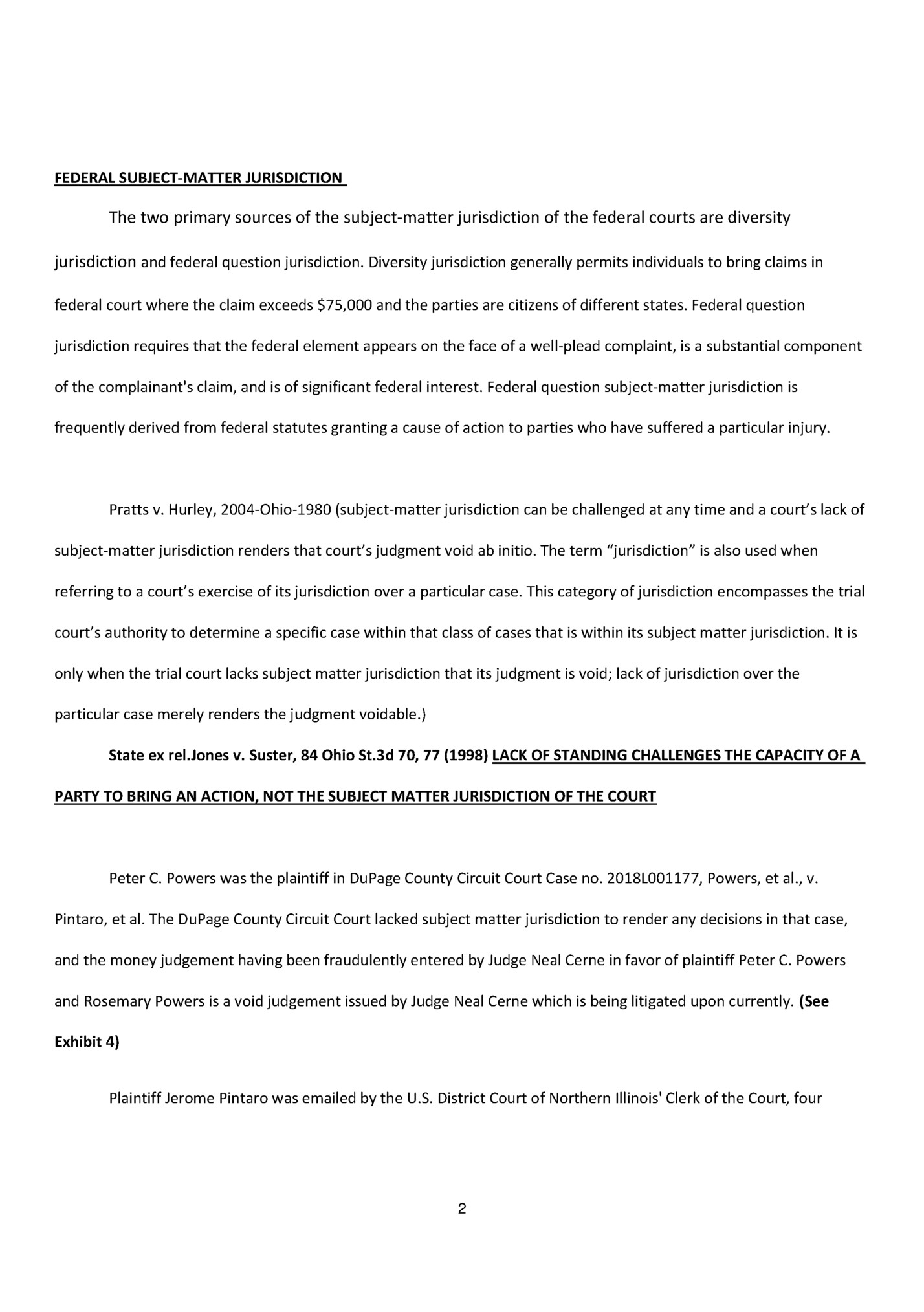
22, 2023, (See Exhibit 5) which named Peter C. Powers as sole defendant on Case no. 23-cv-1425, Pintaro, et al., v. Orel, et al., Peter C. Powers who was never served summons and who was never a legal party to the complaint. Furthermore, the minute entries "made and entered" by the U.S. District Court of Northern Illinois' Clerk of the Court without due process, questionably did not include the names of the legal, current defendants, Attorney Adham Alaily, Dimitri A. Sayegh, and the ficticious named defendant, Madj G. Khoury. Suspiciously, plaintiff Jerome Pintaro was also never served notice by any parties to the Case no. 23-cv-1425, Pintaro, et al. v. Orel, et al, by the U.S. District Court of Northern Illinois' Clerk of the Court, or by Judge Thomas M. Durkin, as to the substitution, addition, or joinder of Peter C. Powers as a defendant in the aformentioned cited case, nor the dismissal, or withdrawl of defendants Attorney Adham Alaily, Dimitri A. Sayegh, or the ficticious Madj G. Khoury. Without notice of any kind, plaintiff Jerome Pintaro immediately contacted by phone, Judge Durkin's courtroom deputy, Emily Wall who indicated by message answering device that she was not in the office. Plaintiff Pintaro then immediately called the U.S. District Court of Northern Illinois' Clerk of the Court who indicated that Emily Wall was out of the office for three months on maternity leave. Another person who was alleged to be taking calls for Emily Wall, a Mr. Bosely, was not able to provide any information as to the change in the named defendants in Case no. 23-cv-1425, Pintaro, et al., v. Orel, et al. As a result of the abscence of any notice relative to Peter C. Powers being substituted, added or joined, and not being able to obtain any information of same from the U.S. District Court of Northern Illinois' Clerk of the Court's office, plaintiff Jerome Pintaro filed a "motion for correction" for "Peter C. Powers" being listed on Case no. 23-cv-1425, as the sole defendant in the case as reported by the U.S. District Court of Northern Illinois' Clerk of the Court. That "motion for correction" will be withdrawn with a motion to be filed, objecting to the illegal substitution, addition, or joinder of Peter C. Powers as sole defendant to Case no. 23-cv-1425 and the illegal withdrawl of the legal defendants without due process or notice, namely, Attorney Adham Alaily, Dimitri A. Sayegh, and the ficticious defendant, Madj G. Khoury. RULE 25. SUBSTITUTION OF PARTIES 3
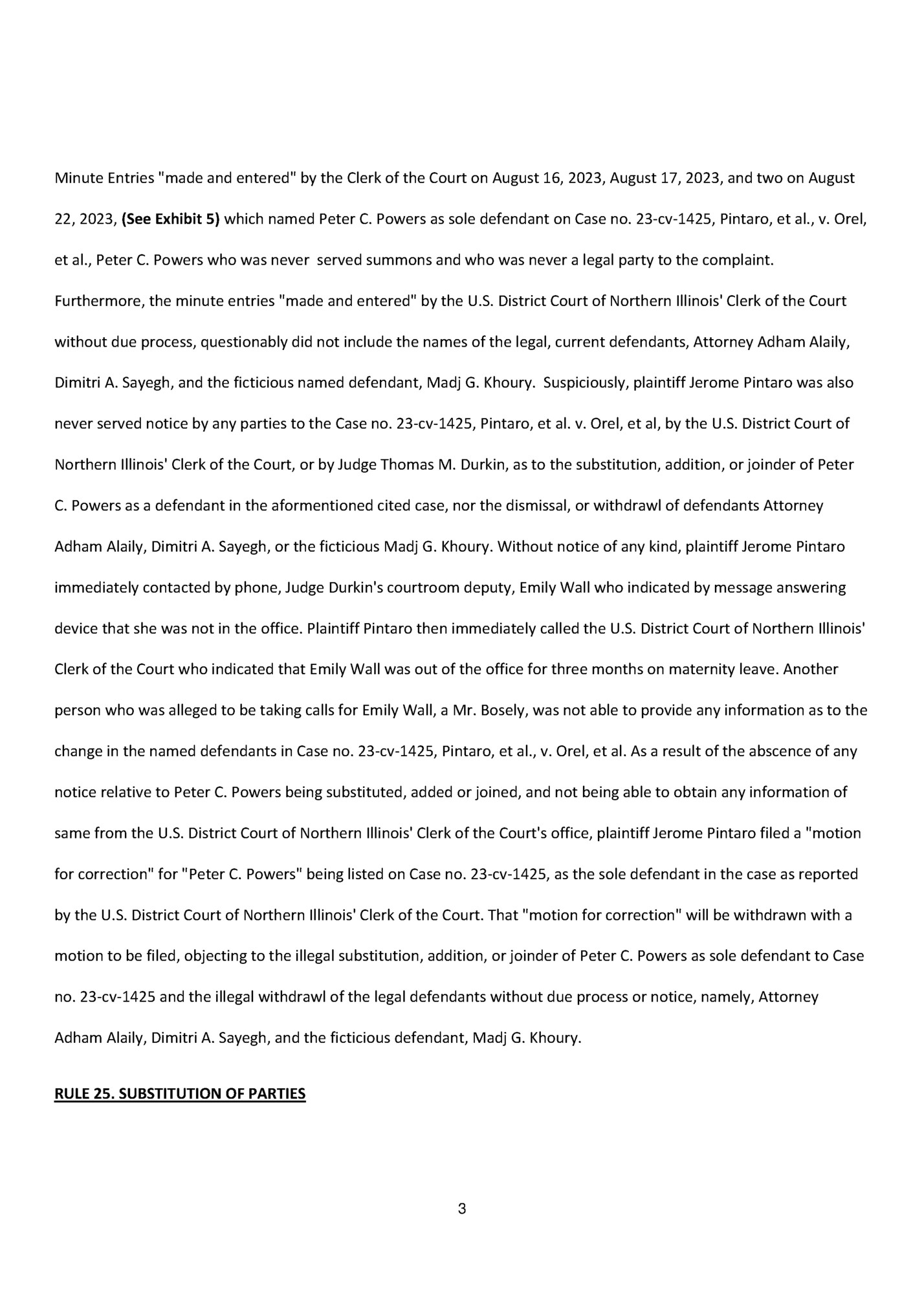
the court, on motion, orders the transferee to be substituted in the action or joined with the original party. The motion must be served as provided in Rule 25(a)(3 ADDING OR DROPPING PARTIES UNDER THE RULES OF CIVIL PROCEDURE There are two federal rules of civil procedure governing the addition and subtraction of parties: Fed. R. Civ. P. 15(a) provides that a party may amend a claim once as a matter of course any time before a responsive pleading is served. If the pleading is one to which no responsive pleading is permitted, and the action has not been placed upon the trial calendar, a party may amend any time within 20 days of service. Otherwise, a party may only amend its pleading by leave of court or by written consent of the adverse party; and leave shall be given freely when justice so requires. Fed. R. Civ. P. 21 provides that misjoinder of parties is not ground for dismissal of an action, and that parties may be dropped or added by court order on motion of any party or of the court's own initiative at any stage in the action and on such terms as are just. In that particular circumstance, courts have been divided on which rule to apply. Admittedly, as the Eastern District of New York observed, there is "little practical difference between Rule 15 and Rule 21 since they both leave the decision whether to permit or deny an amendment to the district court's discretion." Amaya v. Roadhouse Brick Oven Pizza, Inc., 285 F.R.D. 251, 253 (E.D.N.Y. 2012). And so courts have actually granted motions to amend that add or subtract parties pursuant to both Rule 15 and Rule 21. See Hernandez v. Sikka, No. 17CV4792SJFSIL, 2019 WL 1232092, at *5 (E.D.N.Y. Mar. 15, 2019). In Hernandez v. Sikka, the court determined that, where a defendant allegedly served as the plaintiff's "employer," the potential defendant could be subject to personal liability in connection with the plaintiff's claims, and 4
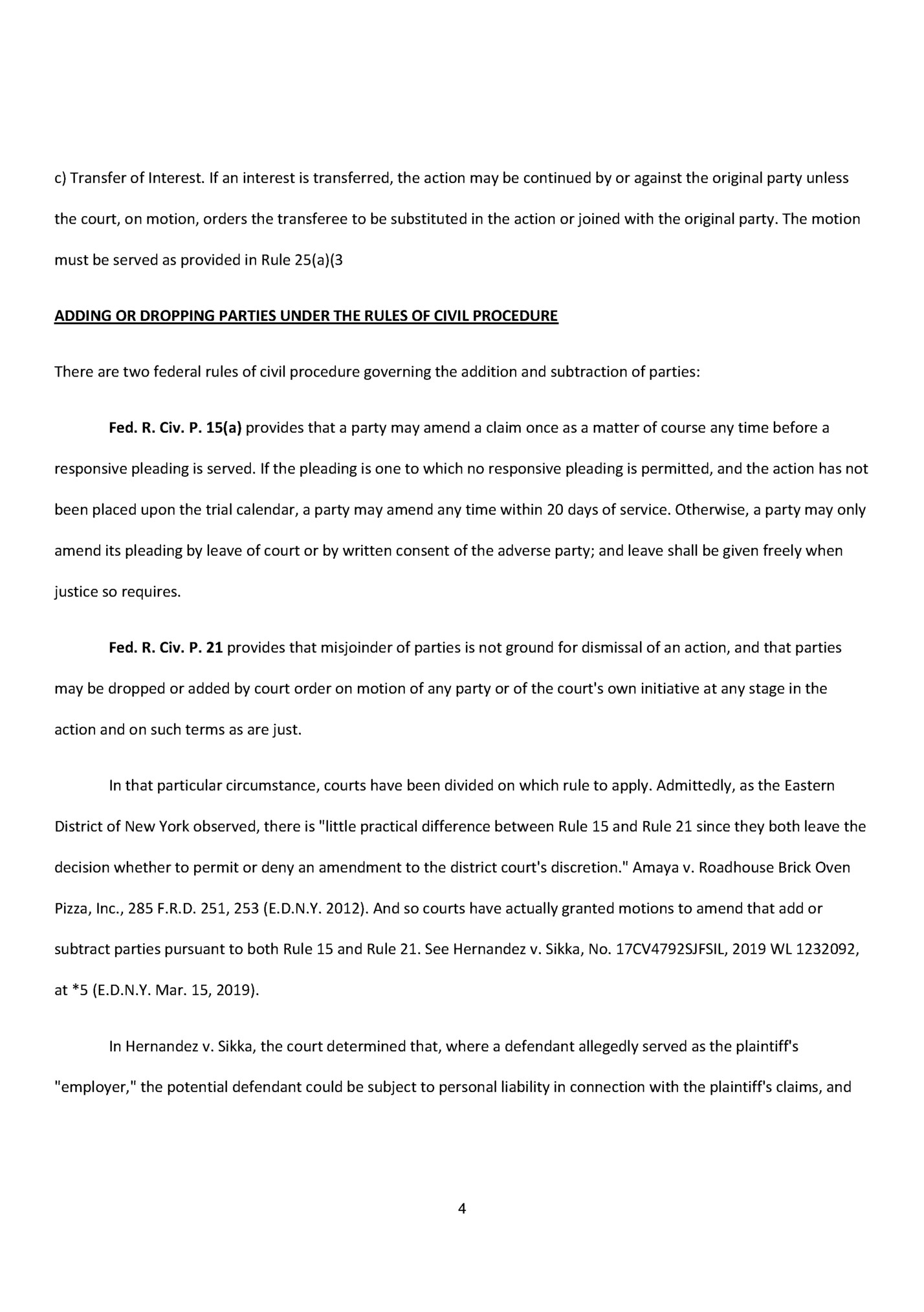
amendment pursuant to both Fed. R. Civ. P. 15(a) and 21. In Hernandez v. BMNY Contracting Corp., the court chose to employ Rule 21, rather than Rule 15, when deciding the plaintiff's request to add new parties without asserting new claims. No. 17 CIV. 9375 (GBD), 2019 WL 418498, at *1 (S.D.N.Y. Jan. 17, 2019). However, the court noted that while it was applying Rule 21, "the consensus in this [district] is that when 'deciding whether to allow joinder, courts adhere to the same standard or liberality afforded to motions to amend [pleadings] under Rule 15.'" This disposition only furthered the idea that the two rules, while sometimes applied differently in different circumstances, are intertwined, and exceedingly similar. Together, Rules 15 and 21 provide movants with an extremely liberal standard to meet. Courts should generally grant motions to amend absent any evidence of bad faith, undue delay, or undue prejudice to the non-movant. Quaratino v. Tiffany & Co., 71 F.3d 58, 66 (2d Cir. 1995). Nevertheless, attorneys should remember that, while the standards are exceedingly liberal, a motion to amend under either Rule 15 or Rule 21 should be expedient and logically sound to ensure a favorable judicial decision. RULE 19. REQUIRED JOINDER OF PARTIES (a) Persons Required to Be Joined if Feasible. (1) Required Party. A person who is subject to service of process and whose joinder will not deprive the court of subjectmatter jurisdiction must be joined as a party if: (A) in that person's absence, the court cannot accord complete relief among existing parties; or (B) that person claims an interest relating to the subject of the action and is so situated that disposing of the action in the person's absence may: (i) as a practical matter impair or impede the person's ability to protect the interest; or (ii) leave an existing party subject to a substantial risk of incurring double, multiple, or otherwise inconsistent 5
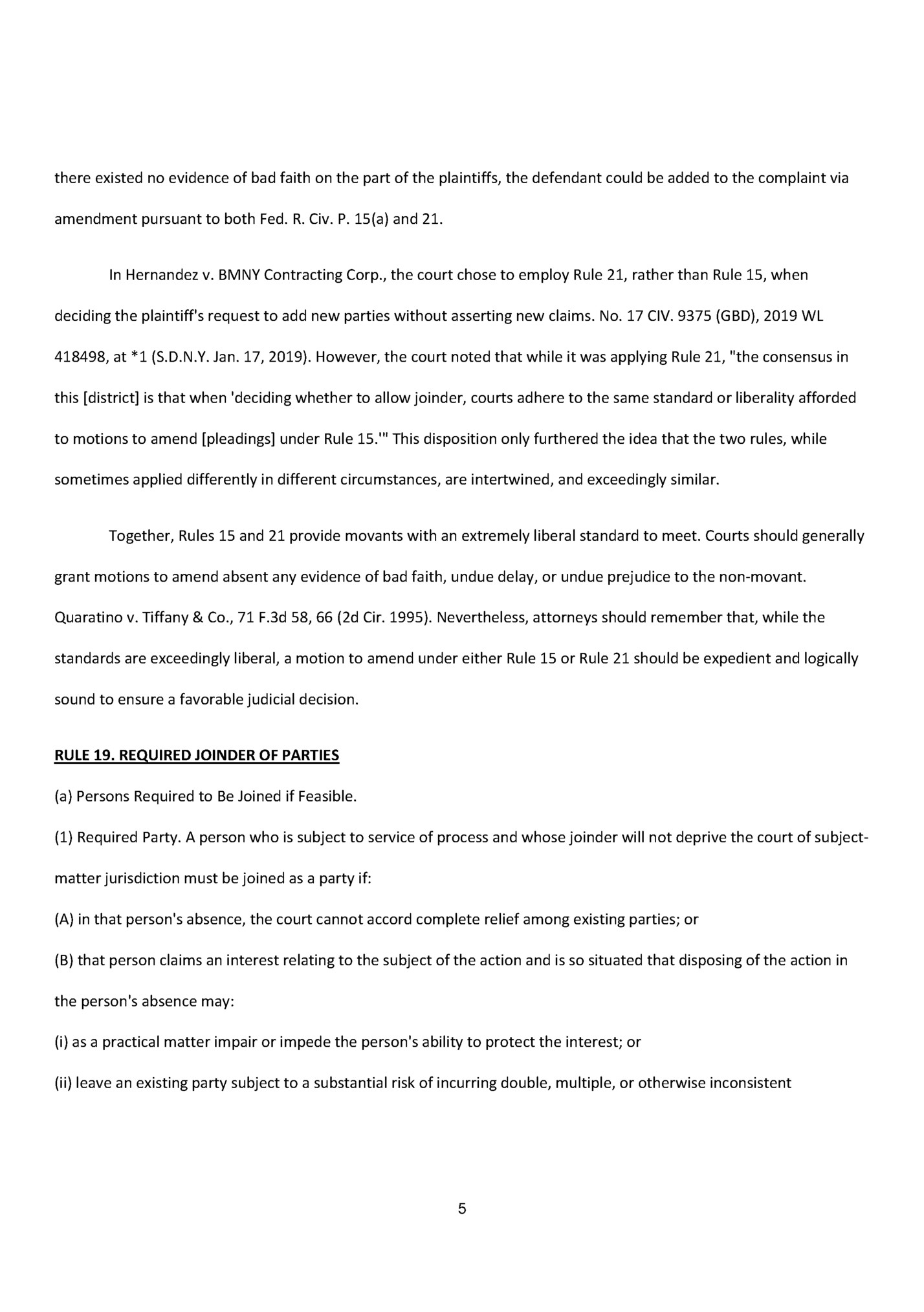
(2) Joinder by Court Order. If a person has not been joined as required, the court must order that the person be made a party. A person who refuses to join as a plaintiff may be made either a defendant or, in a proper case, an involuntary plaintiff. (3) Venue. If a joined party objects to venue and the joinder would make venue improper, the court must dismiss that party. (b) When Joinder Is Not Feasible. If a person who is required to be joined if feasible cannot be joined, the court must determine whether, in equity and good conscience, the action should proceed among the existing parties or should be dismissed. The factors for the court to consider include: (1) the extent to which a judgment rendered in the person's absence might prejudice that person or the existing parties; (2) the extent to which any prejudice could be lessened or avoided by: (A) protective provisions in the judgment; (B) shaping the relief; or (C) other measures; (3) whether a judgment rendered in the person's absence would be adequate; and (4) whether the plaintiff would have an adequate remedy if the action were dismissed for nonjoinder. (c) Pleading the Reasons for Nonjoinder. When asserting a claim for relief, a party must state: (1) the name, if known, of any person who is required to be joined if feasible but is not joined; and (2) the reasons for not joining that person. (d) Exception for Class Actions. Rule 23. STANDING AND PERSONAL JURISDICTION Before a case can be litigated, parties have to demonstrate that they meet two pretrial requirements: standing 6

Standing is a constitutional requirement. Article III of the Constitution grants the judiciary the power to hear “cases” and “controversies.” This means actual cases and controversies, not merely hypothetical ones. Unlike some other jurisdictions, the standing requirement means that courts are unable to give advisory opinions. Standing prevents this question from being litigated, because it’s not yet an actual case or controversy. Standing, therefore, is a doctrine that limits judicial overreach by circumscribing the types of cases that are litigated in our courts. To demonstrate standing, a party has to prove first that it has an actual case to proceed. This is a procedural matter, and it requires the case to be brought at the right time. In addition to being brought at the right time, the case has to be brought by the right person. To show standing, a plaintiff has to demonstrate that he has an actual stake in the litigation, or something of value that would be lost if he loses the case. Of course, if a plaintiff has lost money in a contract dispute or has been injured in a tort case, that is sufficient legal injury. It’s important to note that standing doesn’t have anything to do with the merits of the case. Being able to prove standing doesn’t mean that you can win the case at hand. It only means that you’ve been able to clear a procedural bar toward proceeding with litigation. Another procedural bar before a plaintiff can proceed is personal jurisdiction. Personal jurisdiction is different from subject matter jurisdiction, which is the power of a court to hear a case. Personal jurisdiction is the power of a court over specific litigants, and it requires litigants to have some form of minimum contacts with the state where the case is filed. Personal jurisdiction seeks to avoid inconvenient litigation, even if the case has actual merit. A court obtains personal jurisdiction over the plaintiff when the plaintiff files its lawsuit. Obtaining personal jurisdiction over the defendant can be difficult if not impossible. Typically, there has to be some sort of connection between the defendant and the state where the court is located. Living in the state would create personal jurisdiction. Standing is a constitutional requirement. Article III of the Constitution grants the judiciary the power to hear 7
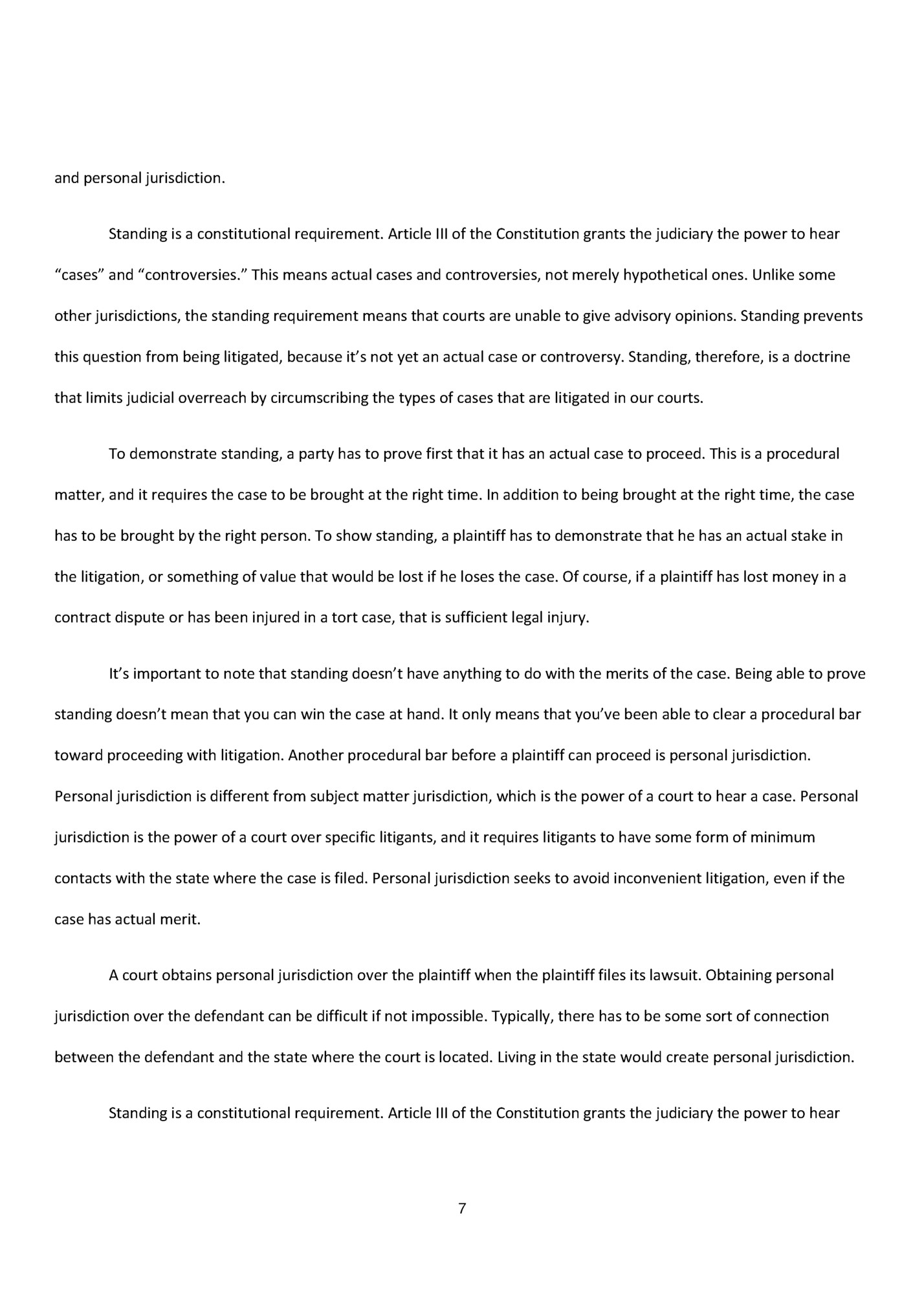
other jurisdictions, the standing requirement means that courts are unable to give advisory opinions or make any decisions. Let’s say, for example, Congress is considering whether or not to pass a law and would like to know whether the law is constitutional. Standing prevents this question from being litigated, because it’s not yet an actual case or controversy. Standing, therefore, is a doctrine that limits judicial overreach by circumscribing the types of cases that are litigated in our courts. The Supreme Court has established a system for determining when a person has standing to bring a claim in federal court. While the rules regarding standing do not appear in the Constitution, the Supreme Court based them on the authority granted by Article III of the Constitution and federal statutes. STANDING “Standing” is the legal right for a particular person to bring a claim in court. A plaintiff must establish that they meet the legal criteria for standing. This generally involves demonstrating an injury and a direct connection to the defendant. If, for example, the plaintiff was injured in a car accident with the defendant, and the plaintiff alleges that the defendant was responsible for the accident, they most likely have standing to sue. Federal courts have developed their own rules for lawsuits that involve questions of federal or constitutional law. ARTICLE III The Case or Controversy Clause of the U.S. Constitution, located in Art. III, Section 2, Clause 1, does not mention the word “standing.” Despite this, it is the basis for many important court decisions addressing standing. One of the first Supreme Court decisions to address standing in this manner was Fairchild v. Hughes, 258 U.S. 126 (1922). The plaintiff in that case sought to challenge the District of Columbia’s ratification of the Nineteenth Amendment, which prohibited the government from denying anyone the right to vote based on their gender. At the 8
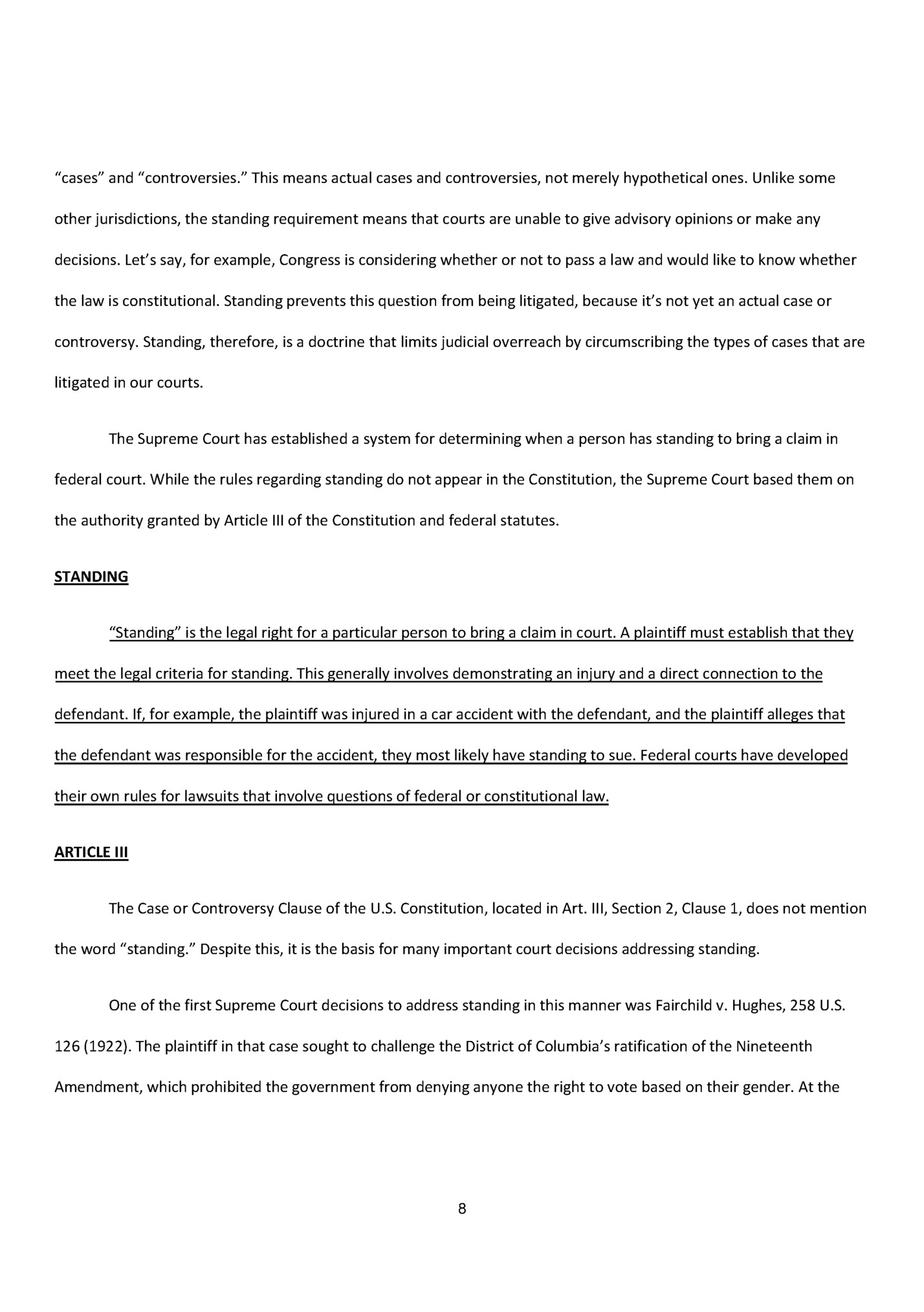
Fleepit Digital © 2021